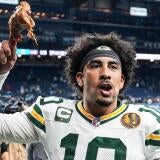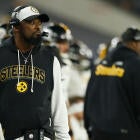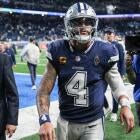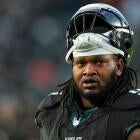
Agent's Take: Predicting how Cowboys and holdout CeeDee Lamb will end their contract standoff
The clock is ticking for Dallas to lock up its superstar receiver
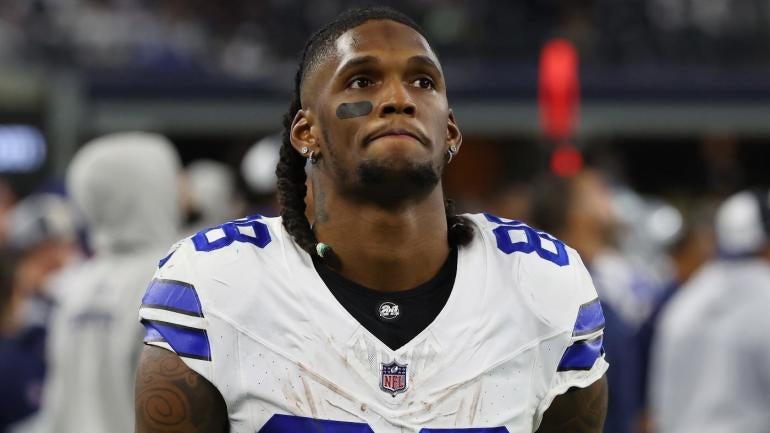
Dallas Cowboys owner Jerry Jones raised eyebrows late last week by stating he didn't have a sense of urgency when asked about getting a new deal done with holdout wide receiver CeeDee Lamb as preseason games were about to start. Lamb can be fined $40,000 for each day he holds out. He is also subject to a fine of 1/18th of his base salary for each preseason game missed because he is in the option year of his rookie contract. Lamb is scheduled to make a fully guaranteed $17.991 million this season with the fifth-year option, so an additional $999,500 is at risk for every skipped exhibition contest. The Cowboys have the ability to waive or reduce any fines since Lamb is still on his rookie deal.
Jones' comments clearly rubbed Lamb the wrong way. Lamb subsequently removed Dallas Cowboys references from his social media bios.
Jones attempted damage control with Lamb ahead of the Cowboys' preseason opener against the Los Angeles Rams on Sunday by clarifying his comments. He said that lack of urgency related to their first regular-season game being four weeks away while adding Lamb wouldn't have played versus the Rams if he had reported to training camp on time. Jones also made of point of mentioning that Lamb was missed.
Putting Jones' comments aside, signing Lamb to a contract extension isn't quite as simple as it may seem, although the wide receiver market is well-defined. Cowboys chief operating officer Stephen Jones revealed on The Athletic's Scoop City podcast about a month ago that Lamb wants to be the NFL's highest-paid non-quarterback.
That distinction belongs to wide receiver Justin Jefferson. The Minnesota Vikings signed Jefferson to a four-year, $140 million contract extension, averaging $35 million per year, during the early part of June.
Jefferson's deal established new wide receiver records for overall guarantees and the amount fully guaranteed at signing, respectively, with $110 million and $88.743 million. The $88.743 million is also the most ever fully guaranteed at signing for a non-quarterback.
Jefferson replaced San Francisco 49ers edge rusher Nick Bosa atop the non-quarterback salary hierarchy. Bosa had become the league's highest-paid non-quarterback last September right before the 2023 regular season started when he signed a five-year, $170 million extension, averaging $34 million per year, with non-quarterback records of $122.5 million in overall guarantees and $88 million fully guaranteed at signing.
Negotiation sticking points
Lamb likely feels being paid more than Jefferson's $35 million per year is warranted after his outstanding 2023 production. He had the greatest receiving season in Cowboys history with 135 catches for 1,749 yards and 12 touchdowns. His 135 receptions not only led the league but were the sixth most ever in an NFL season. Lamb was second and third in the NFL, respectively, in receiving yards and touchdown catches. He was named a first-team All-Pro last season by the Associated Press, Pro Football Writers of America and the Sporting News, which are the recognized media outlets in the NFL collective bargaining agreement that select such honors.
Lamb's case can be bolstered by focusing on the last two seasons when he became Dallas' clear-cut primary receiving threat once Amari Cooper was traded to the Cleveland Browns. Since the start of the 2022 regular season, Lamb has a league-leading 242 receptions. He ranks second with 3,108 receiving yards and 21 touchdown catches.
Paying Lamb more than Jefferson may be problematic for a variety of reasons. The Cowboys probably don't want to set a precedent with Lamb of becoming the NFL's highest-paid non-quarterback. It would ensure that edge rusher Micah Parsons will top the non-quarterback salary hierarchy when he signs a new deal, which will likely happen anyway, presumably next offseason. The 2021 NFL Defensive Rookie of the Year became eligible for a contract extension after the 2023 regular season ended on Jan. 7, 2024. Parsons is under contract for two more seasons because the Cowboys exercised a fully guaranteed $21.324 million fifth-year option with him for 2025.
Lamb had a better 2023 than Jefferson, who missed seven games with a right hamstring injury, but lagged behind his fellow 2020 first-round pick in receiving yards per game. Jefferson averaged 106.4 yards per game to rank second in the NFL. Lamb was third at 102.9 yards per game.
Jefferson is the most productive wide receiver ever through four NFL seasons. He has 392 receptions for an NFL-record 5,899 yards and 30 touchdowns in 60 games. Lamb has 395 receptions for 5,145 yards and 32 touchdowns in 66 games.
Jefferson was named 2022's NFL Offensive Player of the Year after catching 128 passes for 1,809 receiving yards. His 98.3 receiving yards per game are easily the most in NFL history. Hall of Famer Calvin Johnson, whose nine NFL seasons were with the Detroit Lions, is a distant second at 86.1 yards per game.
Another important data point in the Lamb negotiations is probably A.J. Brown's contract. Brown and Lamb are both represented by Tory Dandy.
The Philadelphia Eagles gave Brown a three-year, $96 million extension in late April, averaging $32 million per year, although he had three years remaining on his contract. Brown set a wide receiver record with $84 million in guarantees, which Jefferson shattered. He is the NFL's third-highest-paid non-quarterback by average yearly salary.
It's hard to envision Dandy accepting a contract under the $32 million per year he negotiated for Brown, a player who doesn't quite measure up statistically to Lamb. Brown has 194 receptions for 2,952 yards and 18 touchdowns in the 33 games he started over the last two seasons since joining the Eagles.
Length of contract could be another sticking point in Lamb's negotiations. Dallas prefers to sign players to big money contract extensions that are at least five years long. That was the case with the last two lucrative Cowboys extensions, which were given to cornerback Trevon Diggs and offensive tackle Terence Steele in 2023. Diggs and Steele signed five-year extensions, averaging $19.4 million and $16.5 million per year, respectively.
The continued insistence of a fifth new contract year was an impediment to a long-term deal with quarterback Dak Prescott. The Cowboys relenting led to Prescott signing a four-year contract in 2021 after playing the 2020 season under a franchise tag.
The trend this year is for high-end wide receiver contracts to be shorter. In addition to Brown and Jefferson, four other wide receivers have signed extensions for at least $25 million per year, as 2021 first-round picks DeVonta Smith and Jaylen Waddle received respective three-year extensions from the Miami Dolphins and Eagles for $25 million and $28.25 million per year. Amon-Ra St. Brown briefly became the league's highest-paid wide receiver in late April when he signed a four-year, $120.01 million extension with the Lions, averaging $30,002,500, per year. DJ Moore received a four-year, $110 million extension, averaging $27.5 million per year, from the Chicago Bears at the end of July shortly after training camp opened.
Lamb giving up the fifth year might be a way for the Cowboys to justify going above Jefferson's $35 million per year, especially with a team-friendly structure that's back-loaded like Diggs' and Steele's deals. Diggs' new money percentages after the third and fourth new contract years are 57.22% and 78.35%. It's 58.18% and 78.79% after Steele's third and fourth new contract years. Under a neutral deal, which is neither front-loaded or back-loaded, Diggs and Steele would have been at 60% and 80% after the third and fourth new contract years.
On a five-year Lamb extension totaling $176.25 million for $35.25 million per year, $102.5 million and $138.5 million of new money after the third and fourth new contract years would represent 58.15% and 78.58% of the new money at these points, which would be consistent with Diggs' and Steele's deals. By contrast, Bosa's $34 million-per-year extension has $102.821 million and $136 million of new money after his third and fourth new contract years. The corresponding percentages are 60.48% and 80%.
The Cowboys also have a favorable guarantee vesting schedule in Diggs' and Steele's contracts. Their respective third-year base salaries (the second new contract) in 2025 are guaranteed for injury at signing. Diggs' and Steele's third-year salaries don't become fully guaranteed until the fifth day of 2025 league year. The third-year salary guarantee in the five-year, $100 million contract Cooper signed in 2021 operated the same way as Diggs' and Steele's.
The third year would be 2026 in Lamb's case. With deals of Lamb's magnitude, it is customary for the full guarantee in the third year to vest one year early, unlike with Diggs and Steele, where this base salary would be fully guaranteed in March 2025.
Because of this, Dallas' team-friendly guarantee-vesting schedule would likely be a deal-breaker for Dandy, especially on a five-year deal. Anything less than a neutral deal along the lines of Diggs' and Steele's cash-flow percentages would probably be a non-starter as well.
The gap between Jefferson's guarantees and the rest of the wide receiver market will need to be bridged regardless of the length of Lamb's extension. Brown trails Jefferson in overall guarantees by $26 million. There's an even bigger spread between Jefferson and second place with fully guaranteed at signing. Tyreek Hill's recently reworked three-year, $90 million contract with the Dolphins has $54 million fully guaranteed at signing.
Cracking the top five for overall and full guarantees with non-quarterbacks will likely be a necessity. That would mean more than defensive tackle Chris Jones' $95 million in overall guarantees with the Kansas City Chiefs and edge rusher Josh Hines-Allen's $76.5 million fully guaranteed at signing with the Jacksonville Jaguars.
Prediction
It's hard to imagine Lamb ending his holdout to play under his rookie contract and being designated as a franchise player in 2025. The Cowboys haven't used a franchise tag on any of their first-round picks who were selected after the 2011 CBA created the rookie wage scale. The core players have gotten contract extensions.
A new Lamb deal seems inevitable at some point before serious preparation begins for the Cowboys' regular-season opener against the Browns on Sept. 8. The Cowboys breaking training camp in Oxnard, California, on Aug. 22 could be a date to watch. Timing a new Lamb deal with the Cowboys' return to Texas would be a fitting end to the wide receiver's contract drama.
The Cowboys will recognize that their desired five-year length for an extension doesn't reflect the high-end wide receiver market. Lamb will sign a four-year extension but won't top Jefferson's deal. It won't be surprising if Lamb also falls short of Bosa's $34 million per year. Lamb could end up closer to Bosa than the $33.5 million per year midpoint between Jefferson and Brown's contracts where his deal is between this midpoint figure and $33.75 million per year.
Jefferson's contract will be a roadmap for Lamb's extension. Lamb easily gets the second most overall guarantees and amount fully guaranteed at signing for a wide receiver. He'll rank third all time in these respective categories. His overall guarantees will be between Joey Bosa's $102 million and Jefferson's $110 million. The amount fully guaranteed at signing will be more than T.J. Watt's $80 million and less than Nick Bosa's $88 million.


